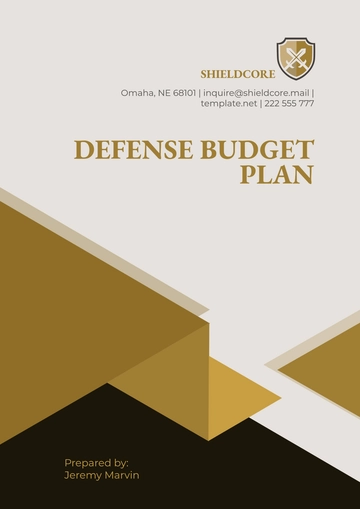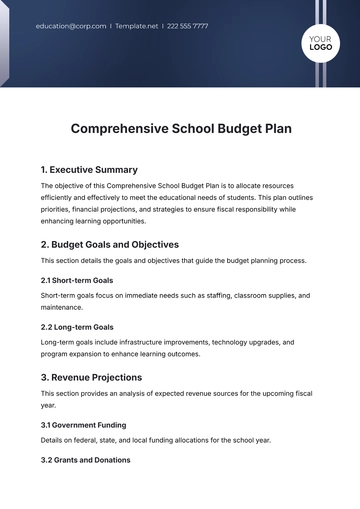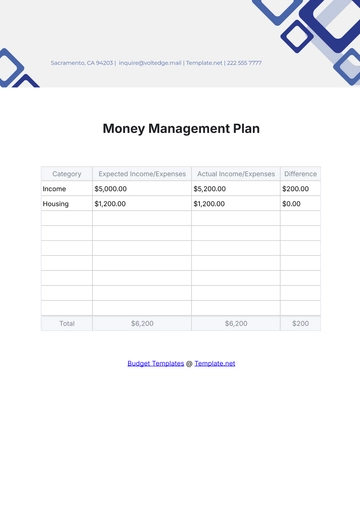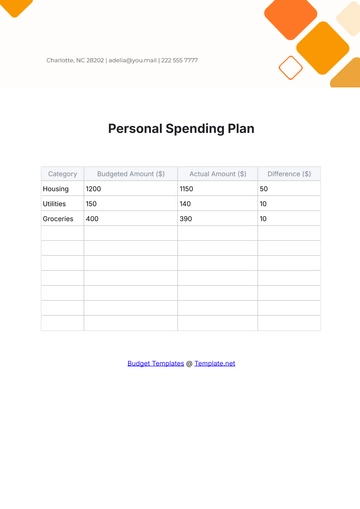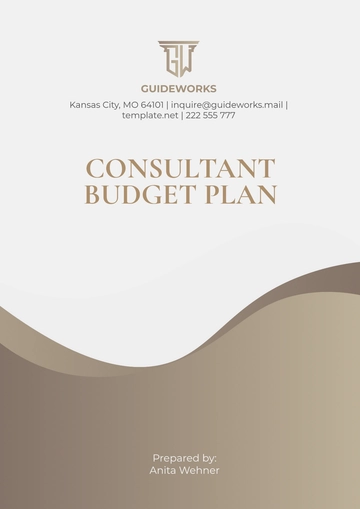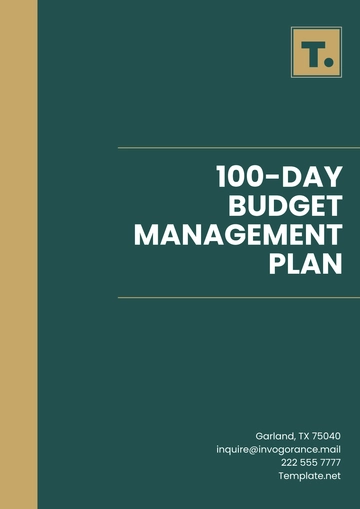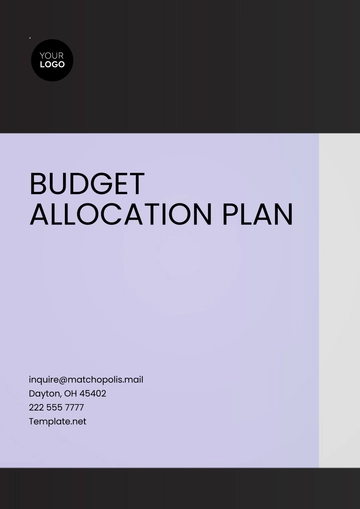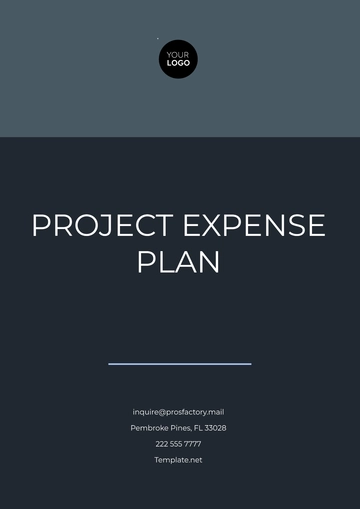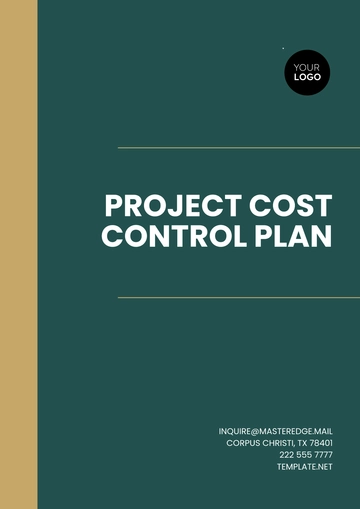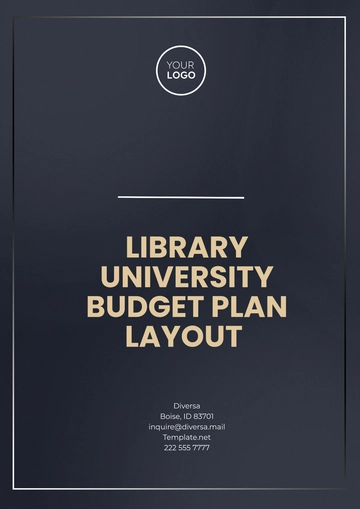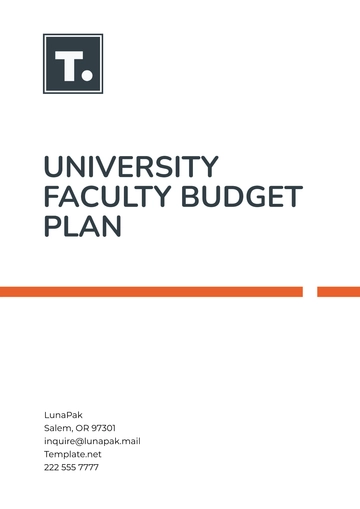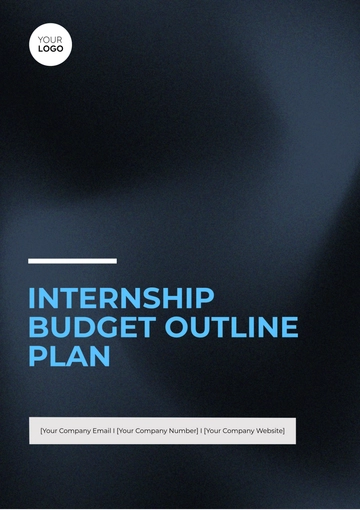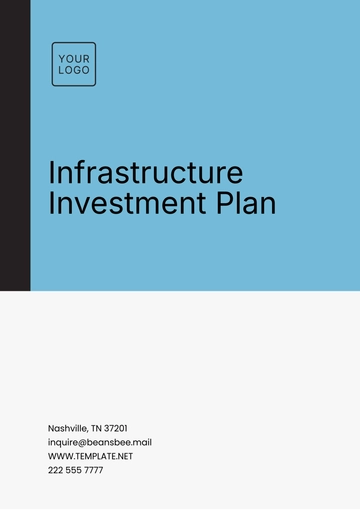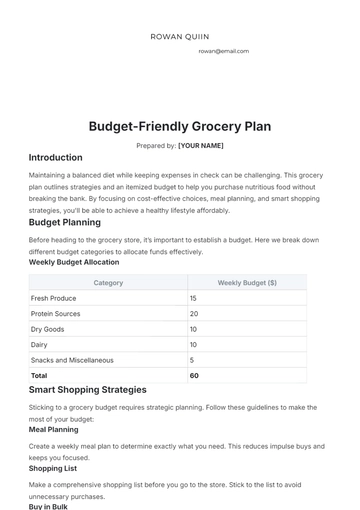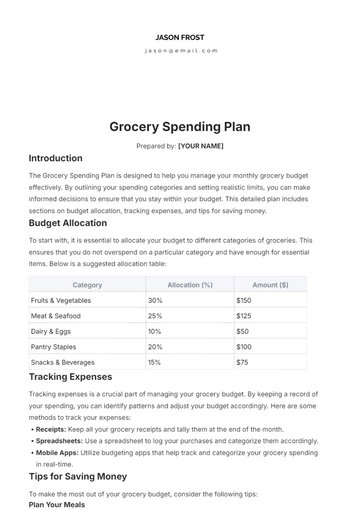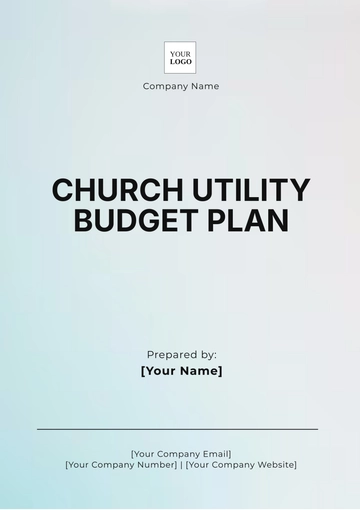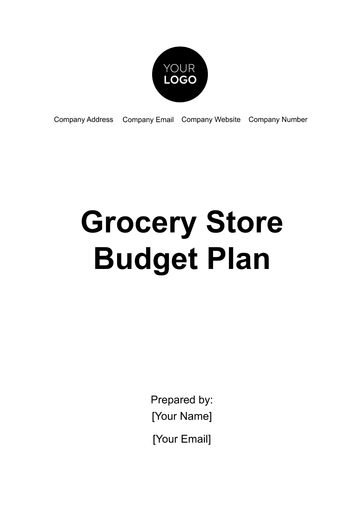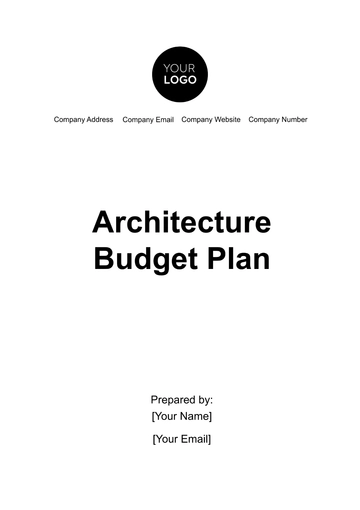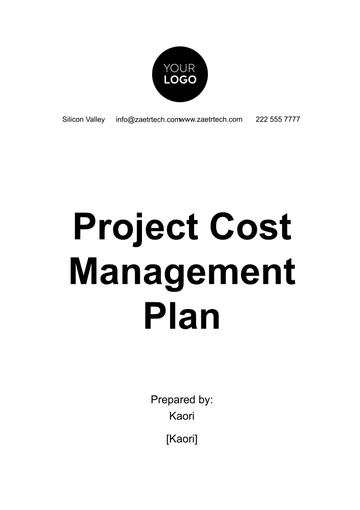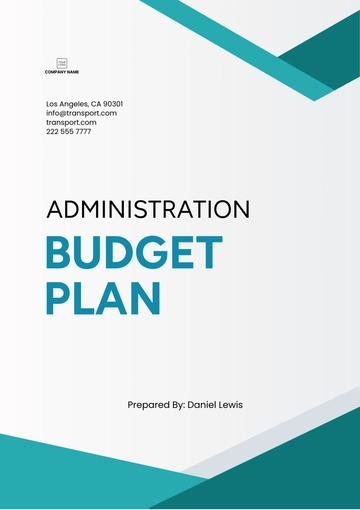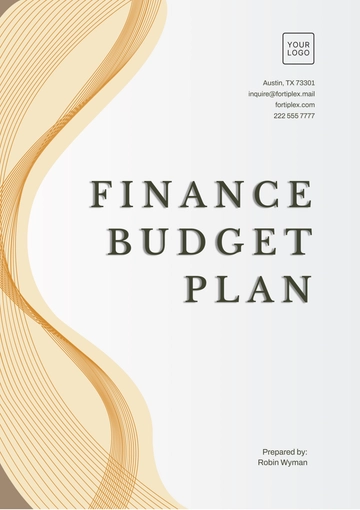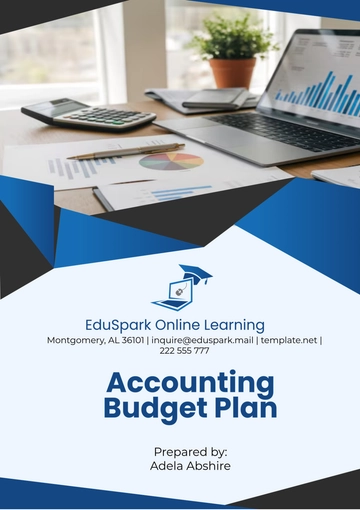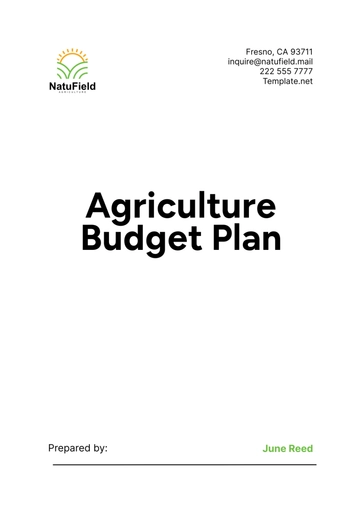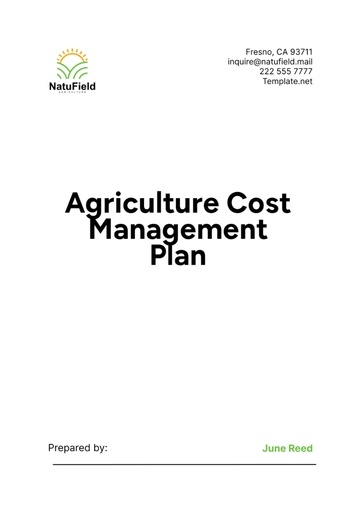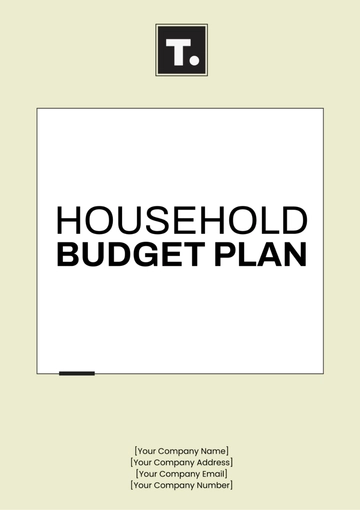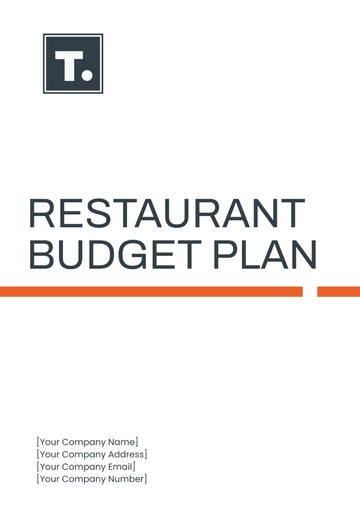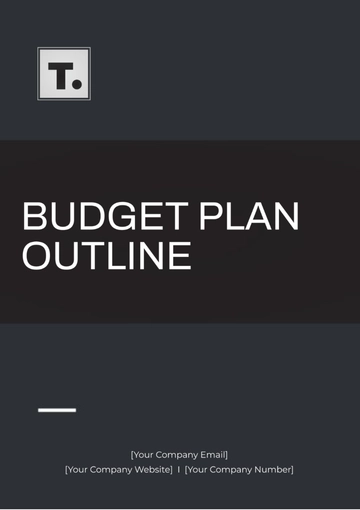Free Nursing Home Annual Budget Plan
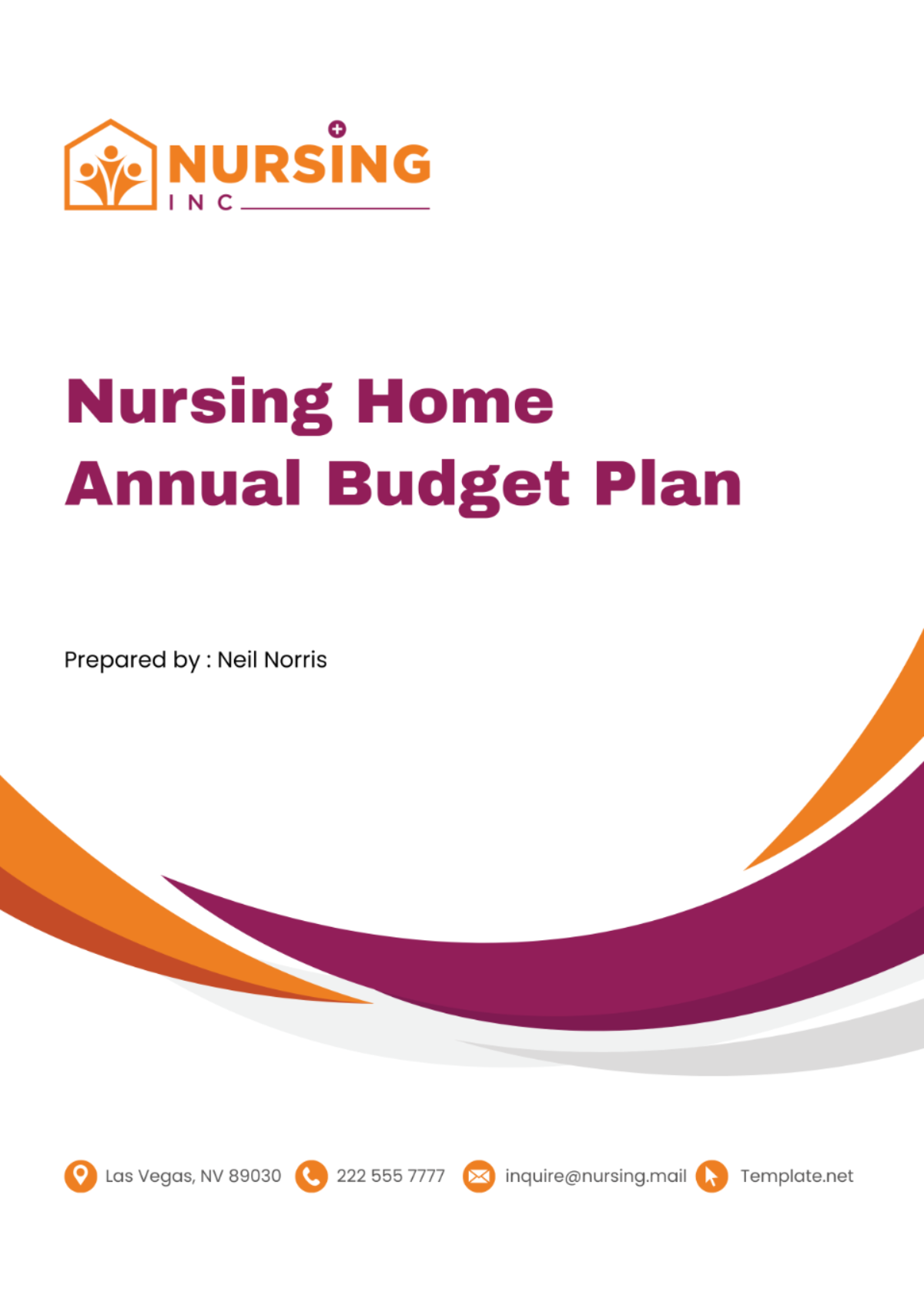
A. Revenue Projection
Welcome to the Nursing Home Annual Budget Plan, a strategic financial document designed to forecast and manage the financial resources of [Your Company Name]. This plan serves as a roadmap for ensuring the provision of high-quality care while maintaining fiscal responsibility in accordance with US laws and standards.
In this section, we meticulously project the various income streams anticipated for the upcoming fiscal year. Drawing from historical data, market trend analysis, and alignment with organizational changes, we present a comprehensive list of potential income sources to guide our financial planning:
Direct Payments from Patients
Insurance Payments (Medicare, Medicaid, Private Insurance)
Government Subsidies (Medicaid, Veterans Administration)
Ancillary Services Revenue (Pharmacy, Therapy Services)
Rental Income (Auxiliary Services, Equipment Rentals)
Investment Income (Interest, Dividends)
Grants and Donations
Other Occasional Income Sources
B. Expense Budget
In the pursuit of operational excellence at [Your Company Name], we meticulously plan and allocate resources to ensure the seamless delivery of care to our residents. Our Expense Budget section provides a detailed breakdown of the myriad expenses involved in maintaining the highest standards of service. From staffing and facility upkeep to utilities and medical supplies, every aspect receives careful consideration. Our budget reflects both ambition and pragmatism, aligning with our commitment to responsible fiscal management.
Expense Category | Description | Amount ($) |
|---|---|---|
Staffing Costs | Salaries, Wages, Benefits | [$0] |
Facility Maintenance | Repairs, Upkeep, Renovations | [$0] |
Utilities | Electricity, Water, Heating | [$0] |
Medical Supplies | Medications, Equipment, Consumables | [$0] |
Administrative Costs | Office Supplies, Software, Staff Training | [$0] |
Other Operational Costs | Transportation, Insurance, Marketing | [$0] |
Contingency Fund | Reserved for Unforeseen Expenses | [$0] |
C. Staffing Plan
Ensuring optimal staffing levels is paramount to delivering exceptional care at [Your Company Name]. In this section, we meticulously analyze staffing requirements across various departments, from nursing to administration, striking a delicate balance between resident well-being and fiscal prudence. With staffing expenses being a significant component of operational costs, our comprehensive plan serves as a guiding blueprint to effectively manage and regulate these expenditures.
Department | Position | Number Required | Total Cost ($) |
|---|---|---|---|
Nursing | Registered Nurses (RN) | [0] | [$0] |
Licensed Practical Nurses (LPN) | [0] | [$0] | |
Certified Nursing Assistants (CNA) | [0] | [$0] | |
Administration | Administrative Staff | [0] | [$0] |
Support Personnel | Support Personnel | [0] | [$0] |
D. Capital Expenditure
At [Your Company Name], we understand the importance of strategic investments in equipment, facility upgrades, and technology to uphold the highest standards of care for our residents. In this section, we meticulously examine the anticipated capital expenditures for the upcoming year and explore various strategies for financing these essential acquisitions. Our goal is to ensure that our facilities remain equipped to provide top-notch care while maintaining fiscal responsibility.
Item | Description | Estimated Cost ($) | Financing Strategy |
|---|---|---|---|
Medical Equipment | Upgrades to Patient Monitoring Systems, Wheelchairs | [0] | Cash Reserves, Equipment Lease |
Facility Renovations | Installation of Handrails, Bathroom Accessibility Modifications | [0] | Small Business Loan, Grants |
Technology Upgrades | Implementation of Electronic Health Records System | [0] | Government Grants, Equipment Financing |
Other Capital Needs | Purchase of New Furniture, Replacement Vehicles | [0] | Purchase of New Furniture, Replacement Vehicles |
E. Contingency Fund
In the dynamic environment of nursing home operations, preparing for unforeseen expenditures is paramount for maintaining financial stability and continuity of care. The Contingency Fund section of our budget plan underscores the significance of establishing a well-structured reserve to effectively navigate unexpected financial challenges. This section is divided into subsections to comprehensively address the strategies for creating and managing a contingency fund.
1. Importance of Contingency Fund
A robust contingency fund serves as a financial safety net, providing the necessary resources to address unexpected expenses without compromising the quality of care provided to our residents. By earmarking funds for unforeseen circumstances, we enhance our ability to respond swiftly and effectively to emergencies, ensuring uninterrupted operations and peace of mind for stakeholders.
2. Strategies for Creating a Contingency Fund
Monthly Allocations: We allocate a fixed percentage of revenue each month towards the contingency fund, allowing for steady accumulation of reserves over time.
Reserve Policy: Our reserve policy establishes clear guidelines regarding the minimum reserve level to be maintained, ensuring that adequate funds are available to address emergencies without depleting essential resources.
Revenue Diversification: We explore opportunities to diversify our revenue streams, reducing reliance on a single income source and enhancing the resilience of our contingency fund.
Budget Surplus Allocation: Any surplus funds from budgetary savings are directed towards the contingency fund, bolstering our financial preparedness and readiness to face unexpected challenges.
3. Managing the Contingency Fund
Investment Opportunities: We carefully evaluate low-risk investment options to maximize the growth potential of the contingency fund while ensuring liquidity for immediate needs.
Emergency Expense Approval: Protocols are in place for accessing contingency funds, with defined approval procedures and criteria for releasing funds in emergency situations.
Regular Review and Adjustment: We conduct periodic reviews of the contingency fund status to assess adequacy, adjust reserve levels as necessary, and refine strategies based on evolving circumstances.
The establishment and prudent management of a contingency fund are integral components of our financial management strategy at [Your Company Name]. By adhering to these strategies, we reaffirm our commitment to maintaining operational stability, safeguarding the well-being of our residents, and upholding the highest standards of care.
F. Budget Assumptions
In this segment, we provide a detailed explanation of the assumptions and methodologies underpinning the creation of our budget. By transparently outlining the factors considered in our financial projections, we aim to provide stakeholders with insights into the rationale behind our budgetary decisions. This section is structured into subsections to comprehensively cover the key assumptions and methodologies utilized.
1. Revenue Assumptions
We base our revenue projections on a comprehensive analysis of various factors, including anticipated changes in reimbursement rates, fluctuations in occupancy levels, and market trends. By incorporating historical data and industry benchmarks, we strive to develop realistic revenue forecasts that accurately reflect the financial landscape of our organization.
2. Expense Assumptions
Our expense projections are informed by careful scrutiny of operational needs, market conditions, and regulatory requirements. We consider factors such as inflation rates, staffing requirements, facility maintenance costs, and anticipated fluctuations in supplier prices. Through diligent analysis, we endeavor to ensure that our expense assumptions are grounded in sound financial principles and reflective of the realities of operating a nursing home.
3. Budget Methodologies
We employ rigorous methodologies to develop our budget, leveraging both quantitative and qualitative analysis techniques. Our approach encompasses trend analysis, regression modeling, scenario planning, and consultation with industry experts. By utilizing a multidimensional framework, we strive to mitigate uncertainty and improve the accuracy of our financial forecasts.
4. Sensitivity Analysis
Recognizing the inherent uncertainty in financial forecasting, we conduct sensitivity analysis to assess the potential impact of external variables on our budget projections. Through scenario testing and stress testing, we evaluate the resilience of our budget assumptions to fluctuations in key parameters, thereby enhancing our ability to adapt to changing market conditions.
The Budget Assumptions segment elucidates the foundation upon which our budget is built, providing stakeholders with a comprehensive understanding of the factors driving our financial projections. By fostering transparency and accountability, we aim to instill confidence in the reliability and robustness of our budgetary framework.
G. Financial Performance Metrics
In this section, we present key performance indicators (KPIs) and financial ratios that serve as benchmarks for evaluating the financial health and operational efficiency of [Your Company Name]. By monitoring these metrics, we gain valuable insights into our financial performance and identify areas for improvement. This segment is organized into subsections to comprehensively cover the essential metrics utilized.
Revenue Metrics
Revenue per Patient Day: This metric measures the average revenue generated per resident per day and provides insight into the facility's revenue-generating capacity.
Occupancy Rate: The occupancy rate reflects the percentage of beds occupied by residents over a specified period, indicating the facility's ability to maximize revenue by filling available beds.
Profitability Metrics
Operating Margin: The operating margin assesses the facility's profitability by measuring the percentage of revenue remaining after deducting operating expenses. A positive operating margin indicates profitability, while a negative margin suggests potential financial challenges.
Net Profit Margin: This metric evaluates overall profitability by comparing net income to total revenue. It provides a comprehensive view of the facility's financial performance, accounting for all expenses and income sources.
Financial Stability Metrics
Debt Service Coverage Ratio (DSCR): The DSCR measures the facility's ability to meet its debt obligations by comparing its operating income to its debt service obligations. A DSCR above 1 indicates sufficient cash flow to cover debt payments, while a ratio below 1 may signal financial distress.
Current Ratio: The current ratio assesses the facility's short-term liquidity by comparing its current assets to its current liabilities. A ratio above 1 indicates that the facility has sufficient assets to cover its short-term obligations.
the Financial Performance Metrics segment provides valuable tools for evaluating the financial health and operational efficiency of [Your Company Name]. By monitoring these key indicators, we can make informed decisions to optimize financial performance and ensure the long-term sustainability of our operations.
H. Patient Services Costs
From essential medical care to enriching ancillary services, we delve into the costs associated with ensuring the holistic well-being of our residents. By evaluating expenditures on medication, medical equipment, testing, therapy, and recreational activities, we gain insights into the resources allocated to providing comprehensive care and enhancing the quality of life for our residents.
Service | Description | Cost ($) |
|---|---|---|
Medication | Prescription drugs and over-the-counter medications | [$0] |
Medical Equipment | Wheelchairs, walkers, medical beds | [$0] |
Testing | Laboratory tests, diagnostic imaging | [$0] |
Therapy Services | Physical therapy, occupational therapy | [$0] |
Recreational Activities | Social events, outings, entertainment | [$0] |
I. Revenue Enhancing Measures
In this section, we focus on exploring initiatives aimed at amplifying revenue streams at [Your Company Name]. By identifying strategic steps to maximize revenue from existing income sources and uncovering potential areas for new income generation, we aim to enhance the financial sustainability of our operations.
1. Maximizing Existing Income Sources
We analyze current revenue streams and implement strategic measures to optimize their performance and yield. This may include initiatives such as:
Enhanced Billing Processes: Streamlining billing procedures to reduce payment delays and improve revenue collection efficiency.
Optimized Insurance Reimbursement: Reviewing and renegotiating insurance contracts to ensure maximum reimbursement rates for services provided.
Occupancy Rate Optimization: Implementing marketing strategies to increase facility occupancy and maximize revenue potential.
2. Exploring New Income Generation Opportunities
We proactively seek out opportunities to diversify revenue streams and explore untapped income sources. Potential initiatives may include:
Expanding Service Offerings: Introducing new services or amenities that cater to the evolving needs and preferences of residents.
Community Outreach Programs: Developing partnerships with local organizations or healthcare providers to offer specialized services or programs.
Investment in Technology: Leveraging technology solutions to improve operational efficiency and generate additional revenue through telehealth services or digital health monitoring programs.
J. Risk Mitigation
In this section, we address potential financial risks and outline strategies to neutralize or minimize these risks within the framework of our budget plan at [Your Company Name]. Additionally, we adopt a balanced approach towards risk-taking to capitalize on opportunities for potential revenue growth while mitigating adverse outcomes.
1. Identification of Financial Risks
We conduct a comprehensive assessment to identify potential financial risks that may impact the financial health and stability of our nursing home. These risks may include:
Market Volatility: Fluctuations in reimbursement rates, changes in healthcare regulations, and economic downturns.
Operational Challenges: Staffing shortages, rising costs of supplies, and unexpected expenses.
Legal and Compliance Risks: Non-compliance with regulatory requirements, potential litigation, and penalties.
2. Strategies for Risk Mitigation
We implement proactive measures to mitigate identified financial risks and safeguard the financial interests of our nursing home. These strategies may include:
Diversification of Revenue Streams: Expanding service offerings and exploring new income sources to reduce reliance on a single revenue stream.
Cost Containment Measures: Implementing cost-saving initiatives, negotiating favorable contracts, and optimizing operational efficiency to mitigate financial strain.
Insurance Coverage: Securing appropriate insurance coverage to protect against unforeseen events and mitigate potential liabilities.
Financial Reserves: Establishing and maintaining contingency funds to provide a financial buffer against unexpected expenses or revenue shortfalls.
3. Balanced Approach towards Risk-taking
While prioritizing risk mitigation, we also recognize the importance of strategic risk-taking to capitalize on opportunities for potential revenue growth. We carefully assess the risk-reward trade-offs and adopt a balanced approach to decision-making, ensuring that our actions align with our long-term financial objectives while minimizing exposure to undue risk.
Through diligent risk management and a balanced approach towards risk-taking, we aim to foster financial resilience and ensure the continued success and sustainability of our nursing home operations.
- 100% Customizable, free editor
- Access 1 Million+ Templates, photo’s & graphics
- Download or share as a template
- Click and replace photos, graphics, text, backgrounds
- Resize, crop, AI write & more
- Access advanced editor
Plan your fiscal year with precision using the Nursing Home Annual Budget Plan Template from Template.net. This editable and customizable template helps structure your financial forecast and allocation, ensuring that all departments of your nursing home are adequately funded while prioritizing essential care and services. Editable in our Ai Editor Tool, it's essential for maintaining financial health, supporting strategic goals, and ensuring the seamless operation of your facility throughout the year.
You may also like
- Finance Plan
- Construction Plan
- Sales Plan
- Development Plan
- Career Plan
- Budget Plan
- HR Plan
- Education Plan
- Transition Plan
- Work Plan
- Training Plan
- Communication Plan
- Operation Plan
- Health And Safety Plan
- Strategy Plan
- Professional Development Plan
- Advertising Plan
- Risk Management Plan
- Restaurant Plan
- School Plan
- Nursing Home Patient Care Plan
- Nursing Care Plan
- Plan Event
- Startup Plan
- Social Media Plan
- Staffing Plan
- Annual Plan
- Content Plan
- Payment Plan
- Implementation Plan
- Hotel Plan
- Workout Plan
- Accounting Plan
- Campaign Plan
- Essay Plan
- 30 60 90 Day Plan
- Research Plan
- Recruitment Plan
- 90 Day Plan
- Quarterly Plan
- Emergency Plan
- 5 Year Plan
- Gym Plan
- Personal Plan
- IT and Software Plan
- Treatment Plan
- Real Estate Plan
- Law Firm Plan
- Healthcare Plan
- Improvement Plan
- Media Plan
- 5 Year Business Plan
- Learning Plan
- Marketing Campaign Plan
- Travel Agency Plan
- Cleaning Services Plan
- Interior Design Plan
- Performance Plan
- PR Plan
- Birth Plan
- Life Plan
- SEO Plan
- Disaster Recovery Plan
- Continuity Plan
- Launch Plan
- Legal Plan
- Behavior Plan
- Performance Improvement Plan
- Salon Plan
- Security Plan
- Security Management Plan
- Employee Development Plan
- Quality Plan
- Service Improvement Plan
- Growth Plan
- Incident Response Plan
- Basketball Plan
- Emergency Action Plan
- Product Launch Plan
- Spa Plan
- Employee Training Plan
- Data Analysis Plan
- Employee Action Plan
- Territory Plan
- Audit Plan
- Classroom Plan
- Activity Plan
- Parenting Plan
- Care Plan
- Project Execution Plan
- Exercise Plan
- Internship Plan
- Software Development Plan
- Continuous Improvement Plan
- Leave Plan
- 90 Day Sales Plan
- Advertising Agency Plan
- Employee Transition Plan
- Smart Action Plan
- Workplace Safety Plan
- Behavior Change Plan
- Contingency Plan
- Continuity of Operations Plan
- Health Plan
- Quality Control Plan
- Self Plan
- Sports Development Plan
- Change Management Plan
- Ecommerce Plan
- Personal Financial Plan
- Process Improvement Plan
- 30-60-90 Day Sales Plan
- Crisis Management Plan
- Engagement Plan
- Execution Plan
- Pandemic Plan
- Quality Assurance Plan
- Service Continuity Plan
- Agile Project Plan
- Fundraising Plan
- Job Transition Plan
- Asset Maintenance Plan
- Maintenance Plan
- Software Test Plan
- Staff Training and Development Plan
- 3 Year Plan
- Brand Activation Plan
- Release Plan
- Resource Plan
- Risk Mitigation Plan
- Teacher Plan
- 30 60 90 Day Plan for New Manager
- Food Safety Plan
- Food Truck Plan
- Hiring Plan
- Quality Management Plan
- Wellness Plan
- Behavior Intervention Plan
- Bonus Plan
- Investment Plan
- Maternity Leave Plan
- Pandemic Response Plan
- Succession Planning
- Coaching Plan
- Configuration Management Plan
- Remote Work Plan
- Self Care Plan
- Teaching Plan
- 100-Day Plan
- HACCP Plan
- Student Plan
- Sustainability Plan
- 30 60 90 Day Plan for Interview
- Access Plan
- Site Specific Safety Plan
